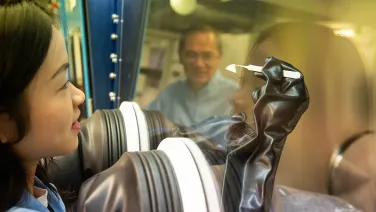Making new metamaterials with quantum dot Lego

Scientists have created materials with surprising optical properties, from arrays of lego-like cubes, made of caesium lead tri-bromide.
Caesium lead tri-bromide is in a class of material known as perovskites, and, as cubic nanocrystals of size ten nanometres, acts as a quantum dot.
By assembling the cubes like Lego into ordered spheres, or supercrystals, an international team, including researchers from the Research School of Physics were able to manipulate the wavelength and brightness of the light emitted from the structures.
The effect is due to the supercrystals operating as meta-atoms: structures smaller than the wavelength of light, which, as arrays called metamaterials, exhibit behaviours completely unlike natural, homogenous materials.
This work, published in Nano Letters, shows the first use of meta-atoms made from smaller components, said the leader of the Nonlinear Physics Centre, Professor Yuri Kivshar.
“The idea of composite meta-atoms appeared some time ago, but it came as a science fiction theory concept,” Professor Kivshar said.
“It turns out that meta-atoms really can be made complex, with the properties being controlled at will. It is surprising that after several years we may say that science fiction became a reality.”
The team chose perovskite nanocrystals because they have an exciton resonance, which leads to strong fluorescence. Collaborators from ETH Zurich in Switzerland created the supercrystals using self-assembly techniques, to form spheres ranging from fifty to several hundred nanometres in diameter and sent them to ANU for the experiments.
PhD Student Pavel Tonkaev then conducted photoluminescence experiments and was able to show that the supercrystals supported Mie resonances, which, combined with the exciton resonance, enhanced the fluorescence, speeding it up by a factor of 3.3.
The supercrystals also shifted the peak wavelength of the fluorescence, by an amount related to their size. Comparing their room temperature experiments with results at 6 degrees kelvin, they also saw the fluorescence peak split into two.
The ability to control the emission by tuning the size and geometry of the supercrystals is a boost for metaphotonics, said Mr Tonkaev, who is the lead author of the journal paper.
“Variations of supercrystal sizes can control the spectral, intensity and kinetic properties of photoluminescence from the supercrystals.”
“This provides a new degree of freedom in all-dielectric metaphotonics, that will provide novel functionalities for future devices.”
This article was first published by ANU Research School of Physics.



